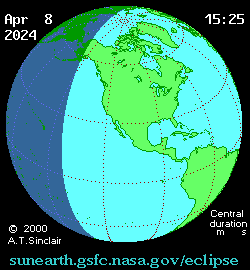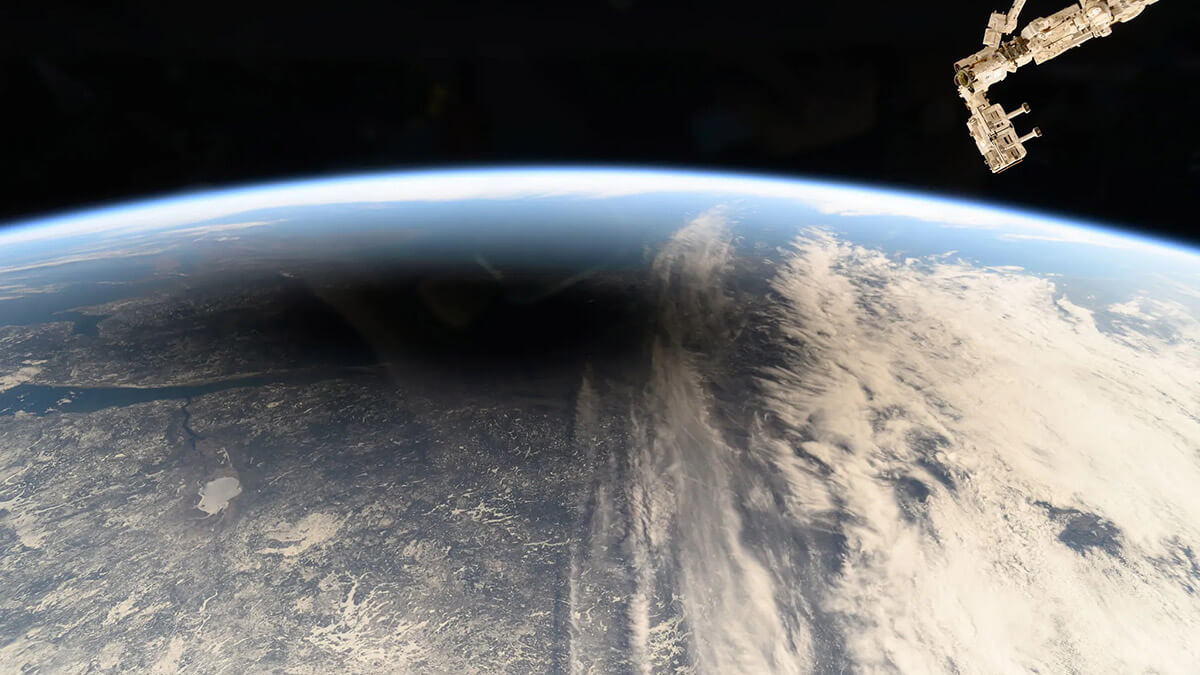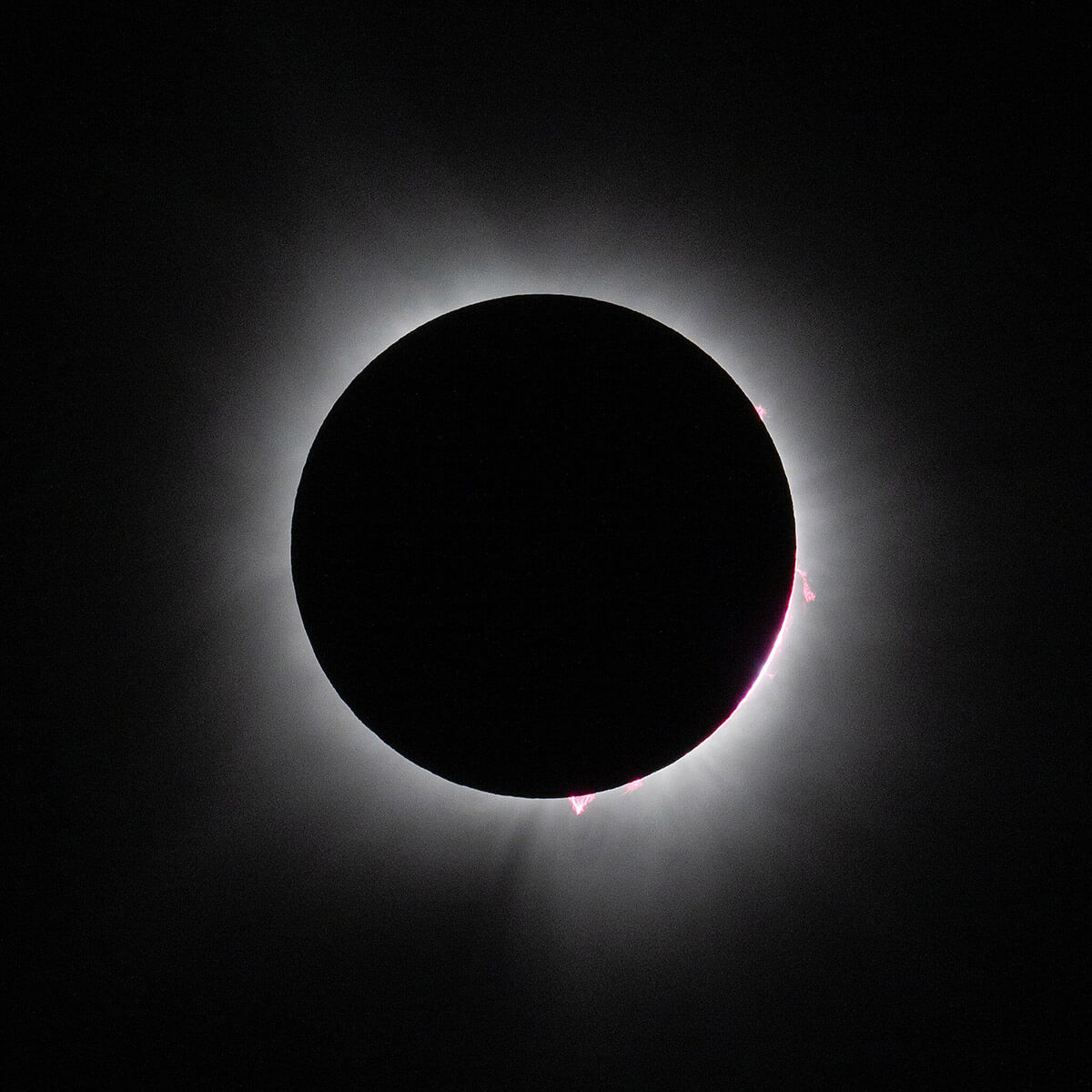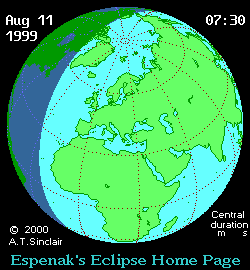TRAC Monthly Report: April 2024
- Category: Monthly Reports
- Author: JM
- Published: 01 May 2024
- Last updated: 16 Dec 2024
2024 Total Solar Eclipse (TSE)
The Astronomical Event of the Year
I hope you enjoyed the 'Eclipse Day' gathering on 08 Apr! I felt that we created a kind of party atmosphere that evening, which is how it should be for such a special occasion, even if we could only enjoy the TSE from over three thousand miles away! I hope that each of us will get the chance to experience a TSE for real at least once in our lifetimes.

Image credit: A.T. Sinclair (NASA)
We joined NASA's live eclipse broadcast a few minutes before the eclipse reached the western coast of Mexico and followed it right across the USA and all the way until it reached the east coast of Canada and headed into the Atlantic Ocean.
According to NASA, the Moon's shadow swept across the Earth's surface at more than 1,500 mph (2,400 km/h)! A photo of the Moon's shadow cast on the Earth was taken from the ISS (below).

Image credit: NASA
I thought it was interesting to see the reaction of the crowd when it started to get dark as the Moon passed directly in front of the Sun. For most of the viewers, it was the first time they had seen a TSE, and I'm sure they will remember it for the rest of their lives.

Image credit: Keegan Barber (NASA)
UK Total Solar Eclipses
Some readers (or their parents/grandparents) might remember the last TSE visible from the UK and parts of Europe on 11 Aug 1999.

Image credit: A.T. Sinclair (NASA)
Here in England, reports describing the eclipse vary, but generally the event was marred by widespread cloud cover, as this BBC News report (originally broadcast on 11 Aug 1999) shows.
The previous TSE seen from the UK occurred on 29 Jun 1927. Adverse weather conditions over large areas of the UK were reported that time, too. Some things never change!
Solar Eclipses: Past & Future
Inspired by the 2024 Total Solar Eclipse, TRAC team member Krum has been researching upcoming solar eclipses and significant solar eclipses throughout human history.
The Longest TSE in History
Krum was curious about the longest TSE in history. He reports that it took place on 15 June, in the year 743 BC off the coast of Kenya and Somalia, and was visible for a record-breaking 7 mins and 28 secs.
I wonder how many people saw it, how they felt, and what they thought was happening. Back in those days, eclipses were hard to predict. Most people had little understanding of science. When the Sun disappeared, it might have been seven and a half minutes of total panic. They won't have known what was happening, or if the Sun would ever reappear! It must have been a huge relief when everything swiftly returned to normal.
Future Solar Eclipses Visible from the UK
Looking ahead, the next total solar eclipse that'll be visible from the UK will be the Total Solar Eclipse of 23 Sep 2090, so we're in for quite a long wait!
But do not fear; we'll be able to experience a closely related solar event much sooner than 2090. Rainham will be in the path of the Partial Solar Eclipse of 29 Mar 2025, starting at 10:08. And luckily for us, it falls on a Saturday.
The TRAC team will be ready for this exciting event!
Comet 12P/Pons-Brooks
Comet Spotting
The 'Devil Comet' (12P/Pons-Brooks) was very faint in March, and we didn't have any better luck at the start of April either. On 01 Apr, most of us were just about able to see the comet from the park using binoculars or the telescope.
With the aid of Stellarium, we located the comet low in the west between Jupiter and the bright star Hamal in the constellation Aries.
Comet 12P only appeared as a faint 'smudge' of light in the eyepiece.
At least we can technically say we've seen a comet, even if the view was not as good as we'd hoped.
The Comet Heads South
Although the comet is getting closer to us, it's now below the horizon from our latitude after dark, so we won't get another chance to see it. Perhaps comet hunters in the southern hemisphere will have more luck.
Don't forget: we'll all meet back at Taverners Road in 71 years' time for the comet's return in the summer of 2095!
Meteors
Space Rocks
On 01 Apr, while looking west towards Jupiter, Charlie saw a meteor flash across the sky. He described it as a bright line of light that moved quickly through the sky and was blue in colour.
A meteor is a lump of space debris that's entered the Earth's atmosphere. Most meteors are only about the size of a grain of sand. They're mainly made of rock and iron, but they can contain various other metals, too.
Different metals produce different colours when they burn. The blue colour indicates that the meteor Charlie saw contained magnesium, a highly reactive alkaline earth metal (Group 2).
Shooting Stars
Meteors are colloquially known as shooting stars, even though they're nothing like actual stars. As they pass through the Earth's atmosphere at high speeds, they heat up due to friction from the air and begin to burn up. Some of the energy released in this process is emitted as visible light.
We'll almost certainly get a chance to see many more meteors in July and August when we observe the annual Perseid meteor shower. But more about that closer to the time!
Stay Alert
It's always worth keeping your eyes peeled for meteors because they occur all year round. Individual meteors are unpredictable and can be seen at any time of the night, usually at a rate of a few per hour under ideal sky conditions.
The longer you spend outside looking up at the night sky, the greater your chance of seeing a meteor. I think a fitting motto for our astronomy club could be "The longer you look, the more you see!" (Remind me to add that to our 'About Us' page at some point!)
Moongazing
April's full moon appeared a touch larger than usual and had a slightly yellowish hue when it was close to the horizon as it rose in the east.
The Moon looked good at 21:00... for about 30 minutes. Then, the cloud moved in, and that was the end of that!
Hopefully, the weather conditions will be better for the May full moon.
Planets
Jupiter
While out looking for the comet on 01 Apr, we briefly took a look at Jupiter and saw three of its moons using the telescope. Astonishingly, Matey was able to discern the positions of the moons without the use of binoculars or the telescope!
We are very fortunate to have someone with such exceptional eyesight in our astronomy group. We'll put his sharp visual powers to the test later in the year, when Jupiter is visible again.
Uranus
The weather conditions just weren't good enough to attempt to see Uranus in April. We'll bide our time and wait for it to reach opposition on 17 Nov.
At opposition, the Sun, Earth, and Uranus will be in an exact alignment. That is to say, Earth will be exactly between the Sun and Uranus on the date of opposition. When the Sun sets in the west, Uranus will rise in the east. The planet will be visible all night long, and it will reach its highest point in the sky at midnight.
Planetary Oppositions
The best time to see the superior planets (those beyond the Earth's orbit) is close to the date they are in opposition. This is because it's when they appear at their largest and brightest in the sky.
When in opposition, a planet appears brighter since it's fully illuminated by the Sun, so more sunlight is able to reflect from it back towards Earth.
Planets appear larger as they often make their closest approach to Earth around the time that they're in opposition. It's also when the planet is above the horizon for longer at night, so we have more time to observe it.
Summary
We had really rotten luck with the weather in April. Even the solar eclipse meetup was affected by the bad weather when it started raining just as we were getting everything set up outside. Unbelievable!
We did have some success this month. Tracking down Comet 12P was our main aim for April 2024, and we did manage to find it!
Unfortunately, there were no decent opportunities for stargazing or satellite spotting during April. We'll carry over those activities to our May 2024 Action Plan.
James M
TRAC Team Leader
01 May 2024 – Rainham, Kent

TRAC is an amateur astronomy group based in Rainham (Kent) in the United Kingdom.
On clear nights, you'll find us outside, observing stars, planets, moons, galaxies, satellites, meteors, and comets.
This monthly report is intended to keep club members informed of our observational activities, track progress towards the club's long-term goals, celebrate successes, and record memorable moments.
Unless stated otherwise, all magnitude values refer to apparent magnitude and have usually been rounded to one decimal place.
We welcome any questions, feedback, or suggestions you may have. Please let us know if anything is unclear or if you notice an error, inaccuracy, or typo. Contact us via email.
© 2024 Taverners Road Astronomy Club